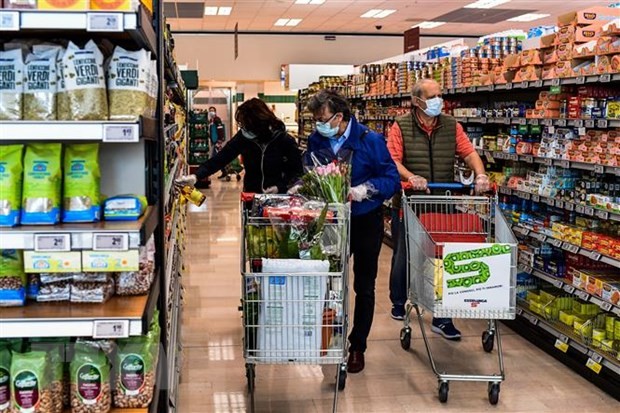(VOVWORLD) - Europe’s economic recovery is being hampered by a COVID-19 pandemic that is still raging and widespread inflation. Regional countries are taking various approaches to minimize impact on their economies.
 Consumers look at goods in a supermarket in Milan, Italy. (Photo: AFP/VNA) Consumers look at goods in a supermarket in Milan, Italy. (Photo: AFP/VNA)
|
A Financial Times survey showed that economists consider inflation the most significant risk factor for recovery and growth in the 19 countries that use the euro as their currency. If inflation remains above the target for most of 2022, the European Central Bank (ECB) will be forced to make stronger policy adjustments, adding to the burden on the economy and posing risks to financial stability.
Concerns about inflation
According to Laurence Boone, chief economist of the Organization for Economic Cooperation and Development (OECD), inflation is a major concern for everyone right now. As in many other parts of the world, prices in Europe have skyrocketed.. The cost of food and energy has increased sharply and is projected to continue rising.
Early this month, the European Statistics Office (Eurostat) said the inflation rate in the Eurozone rose to a record high of 5% in December. This was the highest inflation rate in 25 years (since 1997 when relevant data began to be collected), and much higher than the 2% inflation target set by the ECB. Inflation was particularly high in the Baltic states. Estonia recorded the highest rate, 12%, followed by Lithuania with 10.7%. Among the Eurozone’s major economies, Spain recorded the highest inflation rate, 6.7%, followed by Germany, Europe's largest economy.
The ECB predicts that the rising inflation is temporary, however, and will decrease in 2023, after peaking in 2022. The European Commission (EC) echoed this projection.
 Euro banknotes and coins (Photo: AFP/VNA) Euro banknotes and coins (Photo: AFP/VNA)
|
Change to adapt
EU Commissioner for Economy Paolo Gentiloni said Europe's recovery will depend heavily on pandemic developments, both inside and outside the EU. As daily COVID-19 infections across Europe continue to reach record highs, some countries, nonetheless, have changed their approach and are treating COVID-19 like a seasonal flu.
Spanish Prime Minister Pedro Sánchez said last week that people will have to learn to live with the pandemic, as they have with many other viruses. French Health Minister Olivier Veran said France’s high number of infections and high vaccination rate mean the current outbreak could be the last. Graham Medley, Professor of Infectious Disease Modeling at the London School of Hygiene and Tropical Medicine, said the state of emergency cannot be applied forever. But many other health experts believe it is too early to change the COVID-19 approach. And economists are still wary of the economic devastation more waves of infection could cause.
In the midst of these uncertainties, Europe still saw a bright spot in employment. The Eurozone’s unemployment rate fell from 7.3% in October to 7.2% in November, a significant improvement from a year earlier, when it stood at 8.1% in the Eurozone and 7.4% in the EU. However, voluntary social distancing, waning consumer confidence, and labor market disruptions due to quarantines will slow Europe’s economy in the short term.